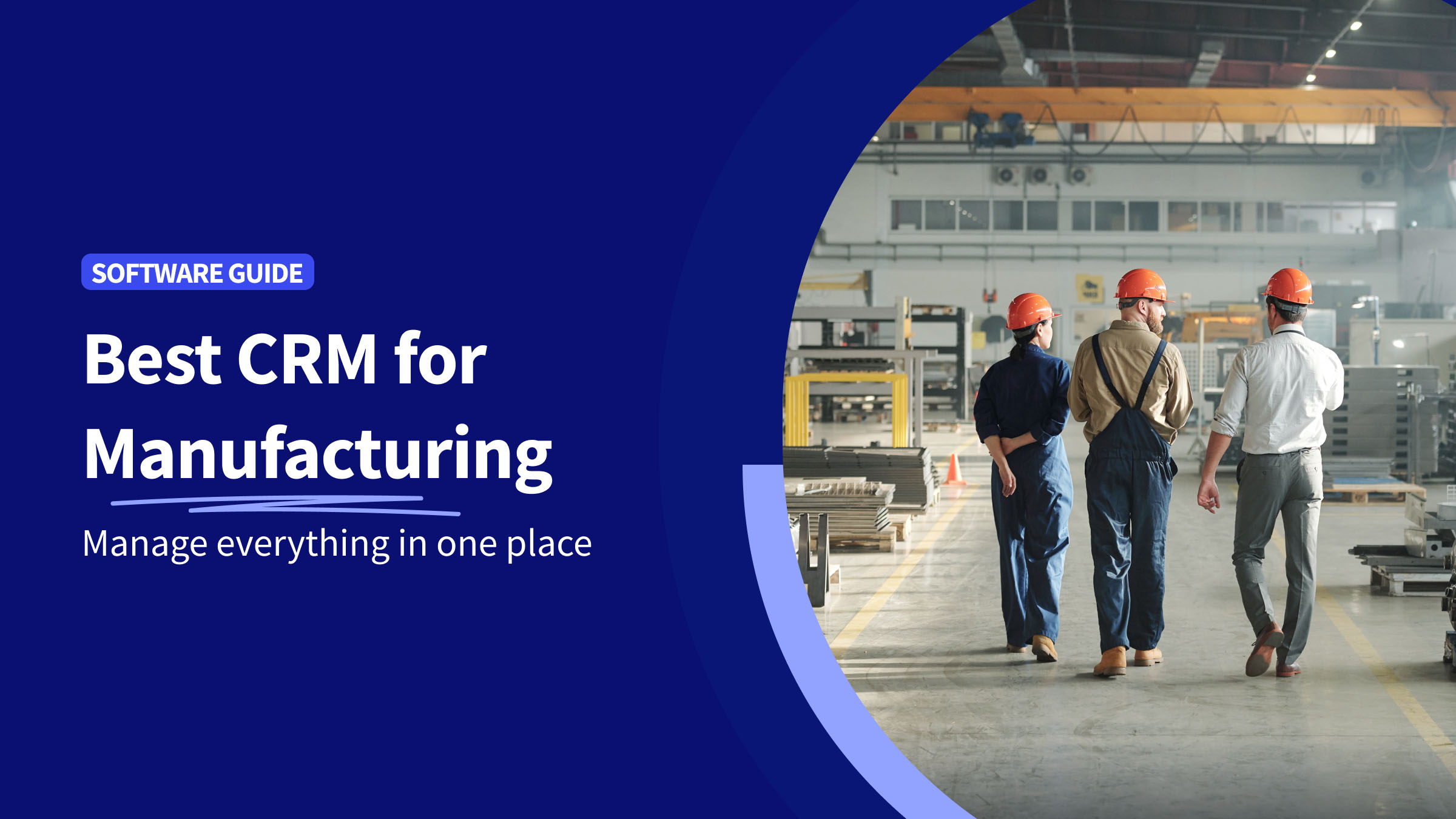All companies that deal with inventory use a supply chain, from small businesses to enterprises.
A well-oiled and efficient supply chain is critical for manufacturing companies who wish to compete in today’s fast-paced market.
This article will discuss the facets of a supply chain for manufacturing and how digitized supply chain management (SCM) solutions can help with optimization.
What is a supply chain?
A supply chain is the network of companies and individuals involved in a product’s lifecycle. That includes everything from the raw materials to the delivery of the finished product to the customer.
Supply chain operations begin with the customer ordering a product.
In its basic form, the links on the supply chain from beginning to end are:
- Sourcing of the raw materials from suppliers.
- Manufacturing the materials into basic parts.
- Assembling the basic parts into a finished product.
- Selling the finished product to the customer or end users.
- Delivering the product to customers or end users.
What are the main supply chain models?
There are several business models for supply chains. But all share two main goals: efficiency and responsiveness, with the end goal being customer satisfaction.
Each model has its own approach to achieving those goals.
Choosing which supply chain model is best for a company largely depends on its goals and specific needs based on the industry.
The main supply chain models are:
- Continuous flow model — Best for established companies that produce the same products consistently.
- Fast chain model — Best for companies whose products depend on trends, such as fashion.
- Efficient chain model — Best for highly competitive markets where pricing is key.
- Flexible model — Best for companies with sporadic production, such as seasonal products.
Now let’s take a closer look at the supply chain for manufacturing.
Supply chain for manufacturing
A product’s lifecycle starts with raw materials and ends when the finished goods reach the consumer.
The manufacturing company is the middleman in this lifecycle.
Upstream operations are the steps leading up to manufacturing in the supply chain. In turn, downstream operations are the steps further down the supply chain manufacturing process.
Upstream operations for manufacturers involve sourcing raw materials through suppliers or vendors. That includes:
- Finding and evaluating suppliers.
- Developing quality standards for the materials.
- Ensuring correct quantities are purchased on time.
After the manufacturer has converted the raw materials into a product ready to sell, the downstream operations come into play.
Those operations involve distributing the finished product to the consumer via wholesalers, distributors, or retailers.
As there are many moving parts, incorporating software for manufacturing would help companies improve the flow of goods and manufacturing capabilities.
Supply chain manufacturing process
The supply chain manufacturing process requires careful planning and managing all parts of the supply chain.
Let’s now look at the main processes involved in a manufacturing supply chain.
- Planning: In this stage, companies develop a strategy that addresses how their products will satisfy the needs and demands of the customer. The main focus is on developing a system that will generate maximum profit.
- Sourcing: This stage focuses on developing relationships with suppliers. Dependable suppliers are instrumental in maximizing the productivity of manufacturing operations. This stage also includes planning different methods for shipping, delivery, and payment of the raw materials.
- Production: This stage consists of the design, production, testing, packing, and delivery of the product. It also provides companies with essential data for determining quality levels, productivity, and production output.
- Delivery: This is the logistics phase, where delivery planning happens once orders are accepted. Establishing warehouses, choosing carriers, and setting up an invoicing system are included in this stage.
- Returns: The final stage in the supply chain manufacturing process involves dealing with the return of a defective product. This stage is crucial to setting flexible and efficient supply networks for handling returned products. This stage also requires responding to customer complaints and queries through a customer service department.
Advantages of manufacturing supply chain management
Manufacturing companies require highly optimized supply chains to get ahead of the curve. Let’s look at some benefits of effectively managing the supply chain for manufacturing.
Take a holistic approach to transformation to capture end-to-end value
Efficient manufacturing supply chain management helps businesses capture value across the entire supply chain.
It lets manufacturing companies identify potential problems throughout the supply chain before they become real issues, allowing for better allocation of resources.
It also ensures continuous improvement of manufacturing processes and quality production.
Transform manufacturing processes for better productivity
By efficiently managing the supply chain for manufacturing, businesses reduce costs, optimize performance, and maximize customer satisfaction.
By leveraging supply chain networks, manufacturers can access improved visibility across their supply chains.
This also lets them make better decisions about supply availability and production timelines to create a streamlined supply chain process.
Boost operational health by identifying skill gaps and building capabilities
A supply chain management system can provide visibility into a manufacturing operation’s demand, supply, and capacity.
This will enable you to track personnel skills and identify areas where training or additional personnel may be needed to meet supply goals.
By developing capabilities in your supply chain, you can remain competitive and improve your overall operational health.
Foster a quality culture to create competitive advantage
Implementing supply chain management in manufacturing processes helps create a quality culture focused on customer satisfaction, cost savings, and product innovation.
This helps you gain a competitive advantage by providing superior services and products.
Leverage digital and autonomous supply chain opportunities
Digital supply chains let manufacturers monitor supply, demand, and capacity in real-time, resulting in better decision-making and faster reactions to market changes.
Autonomous supply chain processes allow for better inventory accuracy, cost savings, and improved customer service.
By leveraging the power of technology, manufacturers can also optimize their supply chain operations for greater efficiency and supply reliability.
Supply chain management vs business logistics management
The terms supply chain management and business logistics management are often used interchangeably.
While both refer to management in a supply chain, they target different aspects of SCM.
Let’s look at the similarities and differences between supply chain management and logistics.
Both SCM and logistics:
- Store, move, and deliver goods efficiently.
- Ensure the smooth flow of goods from the beginning to the end of the supply chain.
- Deal with information or goods and services.
- Lead to increased customer satisfaction.
However, SCM doesn’t only involve logistics management but also other activities, such as production, labor, manufacturing, and delivery.
Logistics is one of many aspects of supply chain management. So, the difference between the two comes down to the focus areas.
The goal of SCM is to optimize the efficiency of processes throughout the supply chain. The goal of logistics, on the other end, is to satisfy customers’ needs on time.
Supply chain management best practices
Supply chain managers must adapt to the global market’s growing scale and speed.
An efficient way to do this is by incorporating the following best practices:
- Facilitate collaboration with all companies involved.
- Generate metrics to measure efficiency.
- Speed up inventory and minimize waste.
- Create a resilient supply chain with short cycles.
- Incorporate supply chain technology.
Manufacturing supply chain solutions
A supply chain management solution bridges gaps in the supply chain and guarantees companies efficiently meet consumer demands.
Companies must adopt a solution tailored to their specific needs to gain a competitive edge.
One way to do this is to adopt business management software that can tackle the pain points in the supply chain for manufacturing.
Method CRM is an excellent option for small to medium businesses in the manufacturing space.
It integrates seamlessly with QuickBooks and Xero, providing a one-stop solution for everything from inventory management to sales fulfillment.
With Method, you can optimize your manufacturing process through these great features:
- Wholesale and manufacturing chart of accounts.
- ATP (available-to-promise) supply chain management.
- Customized price levels and bill of materials (BoM) cost tracking.
- Functionality over multiple locations.
Learn more about Method’s capabilities with this video.
Key takeaways
When making a product, you can liken the supply chain for manufacturing to the circulatory system in your body. Each step in the process helps move materials efficiently from beginning to end.
But the entire system becomes compromised if there is a blockage in one of these veins.
Manufacturers need a comprehensive view of their supply chain to maximize productivity and ensure a competitive advantage.
The best way to do this is by adopting a digitized manufacturing SCM solution, like Method CRM.
In the video below, check out how an integration with Method helped double this shipping container company’s revenue in just three years.
Supply chain for manufacturing FAQs
What are the 3 types of supply chain strategies?
The three supply chain strategies are demand-driven, agile, and collaborative. The first focuses on meeting the consumer’s demand, the second on quicking adapting to demand, and the latter on collaboration between the various parties in the supply chain.
What is the best supply chain model?
Which supply chain model is best depends entirely on the company’s goals and what industry it operates in. The continuous supply model would be best if the goal is to produce the same goods that require slight variation consistently. The fast chain model would be most efficient for fashion, for instance, as companies operate in a trend-based industry.
What is the supply chain process cycle?
The supply chain process cycle involves five main stages, starting with the supplier and ending with the consumer. These stages typically include planning, sourcing, production, delivery, and returns.
Start your free trial of Method CRM today!
Image credit: Kelly via Pexels






